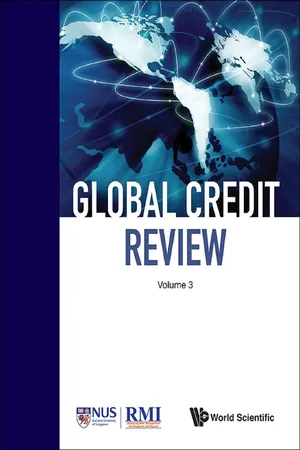
Global Credit Review - Volume 3
Volume 3
Risk Management Institute, Singapore
- 176 páginas
- English
- ePUB (apto para móviles)
- Disponible en iOS y Android
Global Credit Review - Volume 3
Volume 3
Risk Management Institute, Singapore
Información del libro
Global Credit Review is an annual publication that provides an overview of the most important developments in global credit markets and the regulatory landscape. The third volume provides some critical analysis, reviews the introduction of new regulations and also offers new insights to address the challenges ahead. The carefully selected chapters touch on current topics such as: the measurement of systemic risk, reserve requirements and its role in monetary policy, the application of the Basel II default definition by credit risk assessment systems, and changes in credit portfolio management, amongst others. Recent evolutions of the Risk Management Institute's Credit Research Initiative are also reported, including a comprehensive overview of the technical details on the implementation of the current RMI-CRI corporate default prediction model. With its distinctive focus on topics related to credit markets and credit risk, this is an invaluable publication for finance professionals, policy makers and academics with an interest in credit markets.
Contents:
- Systemic Risk in Europe (Eric Jondeau and Michael Rockinger)
- Changes in the Ratings Game — An Update on Various Developments (RMI staff)
- Reserve Requirements as Window Guidance in China (Violaine Cousin)
- The Implementation of the Basel II Default Definition by Credit Risk Assessment Systems: An Analysis of Possible Aggregation Procedures (Markus Bingmer and Laura Auria)
- Can Credit-Scoring Models Effectively Predict Microloans Default? Statistical Evidence from the Tunisian Microfinance Bank (Ibtissem Baklouti and Abdelfettah Bouri)
- Stepping Up to the Liquidity Challenge: The Changing Role of Credit Portfolio Management (IACPM and KPMG)
- NUS-RMI Credit Research Initiative Technical Report (Version: 2013, Update 2b) (RMI staff)
Readership: Finance professionals, policy makers and academics with an interest in credit markets. Key Features:
- A distinctive focus on credit risk related topics that are relevant for academics, policymakers and practitioners, linking rigorous theoretical and empirical research with clear practical implications
- An annual update on global credit market dynamics and financial regulations
- Touches on current topics such as the measurement of systemic risk, the role of reserve requirements in monetary policy, and changes in credit portfolio management
Preguntas frecuentes
Información
Índice
- Cover Page
- Title Page
- Copyright Page
- Contents
- Message from the Editor
- Systemic Risk in Europe: Eric Jondeau and Michael Rockinger
- Changes in the Ratings Game — An Update on Various Developments: RMI Staff
- Reserve Requirements as Window Guidance in China: Violaine Cousin
- The Implementation of the Basel II Default Definition by Credit Risk Assessment Systems: An Analysis of Possible Aggregation Procedures: Markus Bingmer and Laura Auria
- Can Credit-Scoring Models Effectively Predict Microloans Default? Statistical Evidence from the Tunisian Microfinance Bank: Ibtissem Baklouti and Abdelfettah Bouri
- Stepping Up to the Liquidity Challenge: The Changing Role of Credit Portfolio Management: IACPM and KPMG
- NUS-RMI Credit Research Initiative Technical Report (Version: 2013, Update 2b): RMI Staff